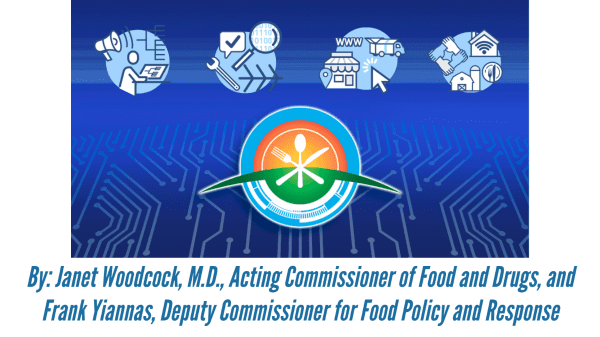By Janet Woodcock, M.D., Acting Commissioner of Food and Drugs, and Frank Yiannas, Deputy Commissioner for Food Policy and Response
One year ago today the U.S. Food and Drug Administration BB #:205523 released the New Era of Smarter Food Safety Blueprint.
During the past 12 months, we’ve made significant progress in working toward the goals outlined in the blueprint, even in the midst of a pandemic.
The blueprint gives shape to the New Era of Smarter Food Safety initiative that the FDA announced in April 2019 to keep pace with the rapidly evolving environment in which foods are being reformulated, new foods and new production methods are being realized, and food delivery systems continue to evolve.

By the time the blueprint was released last year against the backdrop of the COVID-19 pandemic, it was clear that the time had come for the New Era of Smarter Food Safety. We learned from our response as an agency to the pandemic that there is an accelerated need for certain goals in this blueprint, especially those involving supply chain continuity and resilience, modernized inspectional approaches, strengthening food safety infrastructures with regulatory partners, and the safety of foods ordered by consumers online.
We also recognize that the New Era of Smarter Food Safety initiative advances the agency-wide commitment to modernize data and enhance inspections, priorities reinforced in the Data Modernization Action Plan (DMAP) and the Resiliency Roadmap for FDA Inspectional Oversight released in March and May respectively.
The New Era blueprint, DMAP, and Resiliency Roadmap are components of a one-FDA approach to protecting consumers and the public health.
Enhanced Food Traceability
A priority in both the 2011 FDA Food Safety Modernization Act (FSMA) and the New Era of Smarter Food Safety is advancing food traceability to rapidly identify where contaminated foods were grown or produced and speed recalls when necessary.
The first step toward this goal was accomplished when, in September 2020, the FDA published the FSMA-mandated Proposed Food Traceability Rule and a proposed list of foods for which the rule’s additional recordkeeping requirements would apply. The proposed rule lays out key data elements and critical tracking events for enhanced traceability of these listed foods. We held three public meetings on the proposed rule and anticipate issuing a final version of the rule in late 2022.

We learned during the pandemic that enhanced traceability might enable industry and regulators to anticipate disruptions in the food supply chain and possibly avoid the kind of food waste we saw in the early months of the pandemic. As discussed in the DMAP, the ability to track and trace products is critical – whether for quickly recalling a contaminated product or for transforming the way supply chains respond to national emergencies.
Our ultimate goal, as stated in the New Era of Smarter Food Safety blueprint, is end-to-end traceability throughout the food system, and we are taking steps to help ensure that tracing solutions are cost effective for food operations of all sizes. In June, the FDA launched the New Era of Smarter Food Safety Low or No-Cost Tech-Enabled Traceability Challenge. Through July 30, the agency is calling for the submission of food traceability solutions that utilize economic models that are affordable for even the smallest producers and can scale to some of the largest firms – all with an eye toward encouraging widespread adoption.
Predictive Analytics
The DMAP notes the importance of using data from new sources to better understand emerging public health threats. The New Era of Smarter Food Safety blueprint similarly calls for data analysis to strengthen predictive capabilities and make more informed risk management decisions.
To that end, the FDA created a new data analysis tool called 21 Forward to help identify where there could be disruptions in food supply continuity due to food worker absences because of the pandemic. We use COVID-19 human transmission forecast data from the Centers for Disease Control and Prevention to identify areas where COVID-19 could impact key segments of the food system. The tool is also fueled by the estimated numbers and distribution of food and agriculture sector employees who work at FDA-regulated food facilities.
We are also providing data from 21 Forward to help states plan vaccine distribution to food and agriculture workers. The 21 Forward data helps state and local officials determine how many of these essential workers they have in each county and where those workers are located. The 21 Forward data is also part of a broader federal effort to support COVID-19 vaccination of migratory and seasonal agricultural and food sector workers.
Import Screening
The DMAP and the New Era blueprint both highlight the importance of the pilot we have been conducting that leverages artificial intelligence (AI) to strengthen our ability to predict which shipments of imported foods pose the greatest risk of violation and use that information to better target import review resources.
Early findings focused on imported seafood indicate that this tool could significantly increase our ability to know which of millions of shipments to examine because they are more likely to have violative products. The second phase of this pilot was launched in February, applying the AI model to field conditions.
Inspections
In addition to using data to further strengthen a risk-based approach to deploying inspectional resources, the New Era blueprint calls for an exploration of alternative ways to conduct inspections. That plan was put into action out of necessity during the pandemic when routine surveillance inspections were temporarily suspended last year to protect our workforce before being resumed in July 2020.
In April 2020 we began remote inspections of importers subject to the Foreign Supplier Verification Programs requirements. The FSVP rule established by FSMA allows the FDA to request records electronically from importers to help ensure that their foreign food suppliers are meeting U.S. safety standards. By doing this, we have conducted a record number of FSVP inspections since March 2020 – more than 1,600.
The Resiliency Roadmap for FDA Inspectional Oversight cited these remote inspections of importers as critical to the FDA’s efforts to help ensure the safety of imported human and animal foods during the pandemic.
Bending the Curve of Foodborne Illness
We have been able to move forward with a plan launched in the heart of the pandemic. This speaks to the dedication of FDA staff and the commitment to public health demonstrated by our regulatory partners at all levels of government, in this country and other nations.
It also speaks to the food industry’s commitment to protecting consumers. Many of the New Era goals will be executed by industry and we have seen an impressive level of engagement by organizations representing farmers, manufacturers, retailers, and other stakeholders. Our plans are also bringing in new partners, like technology companies.
We have other progress to report in our work to ensure the safety of foods ordered online and those sold in traditional retail establishments, as well as strides made in promoting food safety culture. For more information, please visit the New Era of Smarter Food Safety page on fda.gov. And see the list of New Era of Smarter Food Safety Select Activities for 2021.
Working together, we will bend the curve of foodborne illness in this country, using the right technology, the best data, and the most consistent oversight. Consumers deserve no less.



